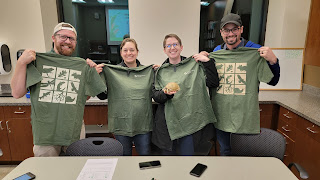Both sessions of Biology Bootcamp this summer flew by as our campers explored and learned about all the different kinds of organisms found on our planet!
Monday - Fish/Reptiles/Amphibians
On the first day of camp we kicked things off by learning about the different kinds of fish (bony, cartilaginous, and jawless) in our rivers, lakes, and oceans. Campers designed and built their own fish, then took a mini field trip down to the museum’s wet collections to take a look at the real deal. Afterwards we talked about the different adaptations of especially interesting fish and how their unique traits help them to survive in each of their habitats. After lunch, it was herpetology time! Campers learned how to distinguish between reptiles and amphibians, and solidified their knowledge with a relay race. Then we met a bearded dragon, learned about translucence, made frog skin slime, and then made our very own salamanders out of beads and string.
Tuesday - Birds
Campers started day two of camp by racing around the museum to find all the different kinds of birds we have. They identified characteristics of each and then competed with different “beaks” (tweezers, straws, spoons, clothespins) and “food sources” (m&ms, beads, cotton balls, rice) to see which one was the best fit! The campers made eco-friendly bird feeders out of pinecones, sunflower butter, and birdseed, and then it was time for lunch. After lunch we rode two stops on the bus down to the campus duck pond to observe how the mallard babies, adolescents, and adults interacted with each other. Campers fed the ducks a healthy lunch of oats and peas, then went to the adjacent field to play water balloon Capture the Flag and talk about how birds protect their nests. Once everyone dried off in the sun, we bussed back up to the museum to paint birdhouses to go with our bird feeders!
Wednesday - Mammals
Who would win in a fight? A lion, leopard, gazelle, or zebra? Just ask our biology bootcamp kids, who know that out in the wild it’s survival of the fittest! For our day on mammals, the kids took on the roles of these animals and fought for points by avoiding poachers with water guns, predatory animals, finding food and water, and completing dares. Not only did we create the African Savanna on BYU campus, but we learned about the adaptations and skills of mammals. After lunch, campers searched around the museum for different mammals and then came back to our classroom to camouflage their own. After educators worked against the clock to find them all, we talked about what makes a mammal and our campers designed and combined different mammals to make the ultimate crossbreed!
Thursday - Plants/Insects
We started day four by packing up our hats and sunscreen into our field trip vans and driving up the canyon to Big Springs park! Along the hiking trail campers completed an insect and plant scavenger hunt, including pollinators, lobed leaves, and moss. After our group hike along the trail, we ate lunch and then split up into groups to explore. Campers climbed logs, waded in streams, and found cool wildlife including beetles, snakes, and birds! Then we packed up the vans and headed back to the museum to learn about what we found. In the afternoon we learned about what makes a bug an insect, how plants help support entire ecosystems, and how different insects have different jobs. We enjoyed some strawberries while learning about pollination, then designed our own specialized insects.
Friday - Zoo!
On our last day of camp we packed up the vans again and headed to Hogle Zoo! Campers put all of their biology knowledge together to explore the different exhibits and discuss each animal with their fellow campers. Snacks were eaten, organisms were explained, and most importantly, sunscreen was applied.
Amy Stevenson, Student Educator





























